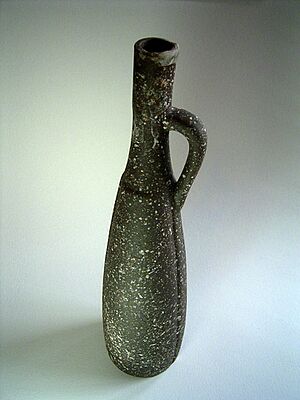Kazakh wine facts for kids
Kazakh wine is wine made in the country of Kazakhstan. The story of winemaking in Kazakhstan began a long time ago, around the 7th century AD. This is when grapevines were first brought to the area. They came from nearby countries like Uzbekistan and China.
Even though only a small part of Kazakhstan (about 4%) is perfect for growing grapes, the country still makes a lot of wine. Each year, they produce over 6.2 million gallons (236,000 hectoliters) of wine. This comes from about 32,120 acres (13,000 hectares) of vineyards. Kazakhstan loves wine! But because people drink so much, the country has to buy about 80% of its wine from other places.
Contents
History of Kazakh Wine
The first signs of grape growing in Kazakhstan appeared around the 7th century AD. This was near the city of Shymkent and in the Tian Shan mountains. These mountains are in Almaty Province, close to the border with Kyrgyzstan. People believe that traders brought grapevines to this area. They came from the Xinjiang region of China and the Fergana and Samarqand areas of Uzbekistan.
For most of Kazakhstan's history, making wine for sale was a small business. In the early 1900s, large vineyards run by the government were the main producers. These were in Almaty, Shymkent, and Taraz. After the Soviet Union broke apart, people became interested in Kazakh wine again. Russia is now a big trading partner for Kazakh wine.
Most Kazakh wine is an inexpensive type called "table wine." However, experts think that Kazakhstan's continental climate could be good for making special "ice wine." Ice wine is a sweet wine made from grapes that freeze on the vine.
Climate and Geography for Grapes
Kazakhstan is a country far from the ocean. This means it has a typical continental climate. This kind of climate usually has very hot summers and very cold winters. Most of the vineyards in Kazakhstan are in the southern part of the country. They are close to the borders with China, Uzbekistan, and Kyrgyzstan. There are also a few smaller grape-growing areas along the Caspian Sea in the west.
The amount of rain each year changes across the country. In wine regions near Atyrau and Aktobe, it rains only about 4-6 inches (100–150 mm). But in areas near the Talas River, it can rain 27-39 inches (700–1000 mm).
Grape Varieties Grown
Currently, winemaking in Kazakhstan mostly focuses on dessert wine. This is a sweet wine often served with desserts. More than 40 different grape varieties grow in Kazakhstan. However, over half of these grapes are used as table grapes (for eating) rather than for making wine.
Some popular grape varieties used for wine include Aligote, Aleatico, Cabernet Franc, Cabernet Sauvignon, Pinot noir, Riesling, Rkatsiteli, and Saperavi. Other local grapes like Muscat Ottonel, Bayan Shirey, Kuljinski, Maiski Cherny, and Rubinovy Magaracha are also grown. Many of these grapes, like Rkatsiteli and Saperavi, are also found in other parts of the former Soviet Union, especially in Georgia. Recently, there has been interest in planting international grapes like Sauvignon blanc. But people in Kazakhstan generally prefer their traditional sweet red wines.
Wine Classification System
At this time, Kazakhstan does not have an official system for classifying its wines. This means there are no specific rules or labels that tell you where a wine comes from or how it was made, like in some other wine-producing countries.
Main Wine Regions
About 80% of Kazakhstan's wines come from the Issyk Winery. This winery is in Issyk, about 25 miles (40 km) east of Almaty. A company from Switzerland bought the winery in 1996, but it was recently sold back to a local company called Dostar. The winery has made many improvements with help from an Italian winery and an Australian expert.
They have rebuilt parts of the winery and brought in "New World" technologies. These are modern ways of making wine, like special fermenters and filters. The Issyk Winery is located high up in the Tian Shan mountains, at 850 meters (2,789 feet) above sea level. This high altitude can be good for growing grapes. Other wineries in Kazakhstan include Bakhus and the Turgen Winery.
There are 210 hectares (519 acres) of vineyards in the Zailiyskiy region of the Almaty Oblast. In the past, during Soviet times, there were more vineyards and wineries in the Sarkand and Alakol regions. But these areas were affected when the Soviet Union broke up.
See also
 In Spanish: Vino de Kazajistán para niños
In Spanish: Vino de Kazajistán para niños



